 Leading Blog | Posts by Month |
 Leading Blog | Posts by Month |
10.31.20

LeadershipNow 140: October 2020 Compilation
See more on
Posted by Michael McKinney at 07:49 AM
10.29.20

Leading Thoughts for October 29, 2020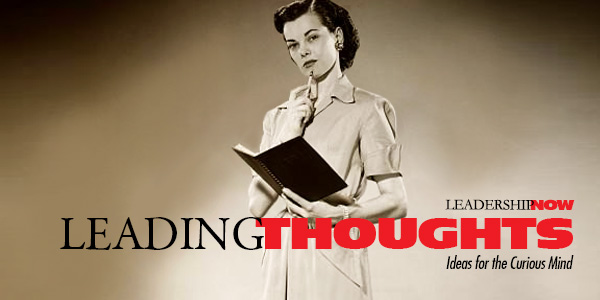
IDEAS shared have the power to expand perspectives, change thinking, and move lives. Here are two ideas for the curious mind to engage with: Carl Schorske on the need to think not just about but to think with history; to employ the materials of the past and the configurations in which we organize and comprehend them to orient ourselves in the living present:: “In most fields of intellectual and artistic culture, twentieth-century Europe and America learned to think without history. The very word “modernism” has come to distinguish our lives and times from what had gone before, from history as a whole, as such. Modern architecture, modern music, modern science—all these have defined themselves not so much out of the past, indeed scarcely against the past, but detached from it in a new, autonomous cultural space, The modern mind grew indifferent to history, for history, conceived as a continuous nourishing tradition, became useless to its projects.” Source: Thinking with History Robert D. Kaplan on the connection between past, present, and future: “The greater the disregard of history, the greater he delusions regarding the future. The classics help counter … historical amnesia. Machiavelli writes: Source: Warrior Politics: Why Leadership Demands a Pagan Ethos Look for these ideas every Thursday on the Leading Blog. Find more ideas on the LeadingThoughts index.
Posted by Michael McKinney at 08:23 AM
10.26.20

Leaders Who Lust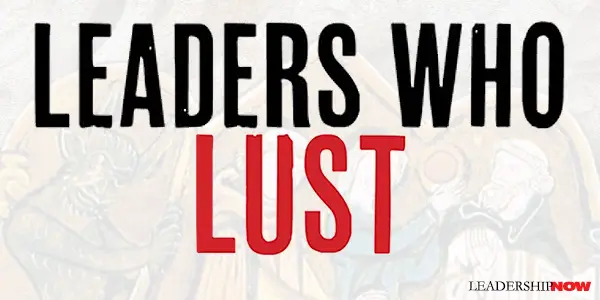
IN 2004, Barbara Kellerman wrote that “the idea that some leaders and some followers are bad, and that they might have something in common with good leaders and followers, has not fully penetrated the conversation or the curriculum” on leadership. And it should because it is true—the good and the bad are an inherent part of us all. Kellerman also rightly asserts in Bad Leadership that “Human nature is human nature, and that makes it inevitable that certain patterns of bad leadership repeat themselves.” And this brings us to Leaders Who Lust by Barbara Kellerman and Todd Pittinsky. Lust is a component of human nature. It is a human nature issue. It is innate, but it is not always acted upon. The determining factor is character—the character to bring the self under control. Lust is a fixation on the self. Kellerman and Pittinsky define lust as: “A psychological drive that produces intense wanting, even desperately needing to obtain an object or to secure a circumstance. When the object has been obtained, or the circumstance secured, there is relief, but only briefly, temporarily.” Their definition helps to separate it from determination and grit. The difference really comes down to motivation and closure. And no matter how many times a lustful leader might insist, “I’m doing it for the people” or “to do good for the world,” the “people” can see through the rhetoric to the selfish motivation behind it. They note that lust can result in good or bad outcomes. Leaders can harness their lust for the common good, or “leaders who lust can as readily harness their prodigious energies to foster murder and mayhem.” They cover six different types of lust that are the most indicative and important to leadership and two individuals that typify that form of lust. Power: the ceaseless craving to control. Examples: Roger Ailes and Xi Jinping Money: the limitless desire to accrue great wealth. Examples: Warren Buffett and Charles Koch Sex: the constant hunt for sexual gratification. Examples: John F. Kennedy and Silvio Berlusconi Success: the unstoppable need to achieve. Examples: Hillary Clinton and Tom Brady Legitimacy: the tireless claim to identity and equity. Examples: Nelson Mandela and Larry Kramer Legacy: the endless quest to leave a permanent imprint. Examples: Bill and Melinda Gates and George Soros While all of these examples are instructive and, in some cases, are cautionary, not all of these examples seem to fit the definition of pure, unadulterated lust. Some may have other issues driving their behavior. In any event, I always find Kellerman to be very insightful. When it comes to lust, the underlying issue is control—an attempt to bend reality to your wishes. In most cases, lustful leaders believe that they are doing right by pushing their agenda. When lust doesn’t get the results a leader wants, it is easy to point to some bias or prejudice, as the authors do in a few of the examples. And certainly, for some, it is a hurdle they must overcome, but further examination often uncovers other character flaws and abusive personalities undermining lustful leaders. Success often points to a degree of self-awareness where the leader has been able to consider their context and adjust accordingly. Some leaders who lust are fortunate. Depending on the object of their lust, on their level of self-control, on who are their followers, and on the circumstances within which they are situated, some leaders who lust can use it to good effect. By “use it to good effect” we mean that such leaders can meet one or another need or want of their own, if only temporarily, while simultaneously meeting one or another need or want of their followers. It does raise the question as the authors do, does moderation lead to mediocrity? The answer, of course, is no. They are two different issues. The fact that some succeed without moderation does not indicate causation. Sometimes a leader succeeds on the surface regarding their agenda in spite of their flaws, but they do pay a price. Lust is not taught, but it does exist in our human nature. That said, the example of a lustful leader can arouse others to follow in their footsteps in an effort to get what they want. Some of the lust lessons they enumerate are: Lust can and sometimes does overwhelm common sense—which is, however, not by definition a deficit. “Sometimes lust overtakes common sense with results that are not only positive, they are downright exciting. One could even argue that the great dreamers in history, the great movers and shakers, are not usually known for their common sense. Rather they are known for having driving passion and vaulting ambition—levels of passion and ambition that not only are not reasonable, that are downright unreasonable.” That unreasonableness may take them to new levels of achievement or understanding that was not thought possible. Lust is an inordinately powerful motivator—perhaps the most powerful motivator of all. “We primarily conclude that lust, as much as or maybe even more than anything else, distinguishes merely ordinary leaders from obviously extraordinary leaders.” Lust certainly drives people to perform in ways that are inspiring. The intense focus that lust can bring can move mountains. This leads us to the next observation. Leaders who lust generally are in control, not out for control. “Lustful leaders do not usually behave in ways that are beyond the pale—they are not crazy. Generally, they channel their drive; if they did not, they would increase their chances of being ousted.” This is true in almost all cases as long as that leader feels they are moving forward. But leave them with no rational alternatives, and they often resort to unethical, outlandish behaviors to de-escalate the dissonance building up in their own mind. We admire lustful leaders for their drive and discipline. The difference between lust and drive is closure. With lust, the self is never satisfied—the goalpost keeps moving further on. The challenge for us is to know where drive ends, and lust begins. At what point does pushing our own agenda become destructive and what is it we are really after. Self-examination is key if we are going to avoid the pitfalls of lust. 
Posted by Michael McKinney at 01:11 PM
10.23.20

Want an Ideal Team Player? Find an Introvert
WHILE the introverts at the office may not be top-of-mind when it comes to assembling a project team, you could be overlooking valuable contributors. Too often, the ideas of introverts are drowned out, yet when sought out, can have true merit. Management guru and prolific author, Patrick Lencioni, wrote about the three characteristics of an ideal team player – hungry, smart, and humble. That third trait, which includes sharing credit and defining success collectively rather than individually, is one most often associated with introverts. A measure of an effective team is that it utilizes all team members’ strengths. Introverts are keen observers, listeners, and deep thinkers. Without unlocking the introverted voice, teams won’t achieve their true potential. Teams involving both introverts and extroverts get exponentially more accomplished. It’s like having one group that can see close up and one that can see into the distance. Here are five approaches to more inclusive team meetings that insure introverts’ input: 1. Implement a 1-minute rule. Ask that each team member speak for 1 minute on a work-related topic. In structuring team meetings so that everyone has a chance to contribute for the same (short) amount of time, introverts are ensured the same opportunity to be heard as their extroverted counterparts. 2. Pair up. Pat Wadors, chief talent officer at ServiceNow, structures team meetings to be more inclusive by pairing up team members. They can privately check in with each other via chat or a program like Slack to see if either needs more explanation or context. Extroverted team members can advocate for introverts if they want to make a comment and are having trouble interjecting their thoughts. Additionally, the buddy system helps to increase compassion and understanding among team members and build one-on-one relationships. 3. Create team member user manuals. Consider the creative technique of asking team members to write their own user manuals that help others understand how they like to work. It can include their collaboration style, ideal times of the day for group and solo work, their motivations and stressors, and their interests in and outside of work. User manuals are a great tool for introverts – who often prefer written communication – to let the rest of the team know their preferences. 4. Consider teams of two or three. Introverts often prefer one-on-one or small-group meetings to larger ones. Instead of all-person team meetings all of the time, consider breaking up your team into smaller groups. These groups of two or three can focus on specific tasks. Encouraging these smaller groups to take walking meetings may also make it easier for introverted team members to speak up. Walking while talking helps to get introverts out of their head and facilitates the flow of ideas as they think on their feet (literally). 5. Foster transparency. Consider using a design or system map to get both introverts and extroverts involved. According to Service Design Tools, this is a representation showing in a single frame all the different actors involved and their mutual links – such as flows of materials, energy, information, money, documents, and more. You can display it and add or remove Post-it notes to provide supplementary information. Too often, introverts are expected to yield the floor to extroverts who are very comfortable with speaking up. Teams who include everyone’s voice will engage the introverts on the team. The team will find a well of resources in their quiet, calm contributors as well as their expressive, energetic ones.  
Posted by Michael McKinney at 03:10 PM
10.22.20

Leading Thoughts for October 22, 2020
IDEAS shared have the power to expand perspectives, change thinking, and move lives. Here are two ideas for the curious mind to engage with: Entrepreneur and investor Sam Altman on the importance of value: “All companies that grow really big do so in only one way: people recommend the product or service to other people. Source: The Only Way to Grow Huge East Rock Capital co-founder Graham Duncan on taking responsibility for your life: “One great portfolio manager I know told the story of being driven somewhere by an analyst on a rainy night when a truck swerved and almost ran them off the road. ‘Why is stuff like this always happening to me?’ the analyst instinctively responded. But to the portfolio manager, that response reflected a terrible mindset, whether on the road or in the market: a sense that the world is acting on you as opposed to your acting on the world. It is a mindset that is hard to change. But from what I’ve seen, great investors don’t have it. Instead, they’ve come to understand which factors in the market they can control and which factors they cannot.” Source: The Playing Field Look for these ideas every Thursday on the Leading Blog. Find more ideas on the LeadingThoughts index.
Posted by Michael McKinney at 10:24 AM
10.21.20

Three Questions We Have of All Leaders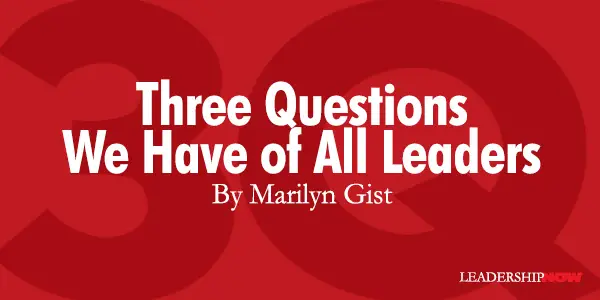
WHENEVER we work with leaders, we have our own important worries—things like fairness, the amount of change we’re being asked to embrace, and our own personal goals. When you think about it, we have three prime questions when facing any leader. Whether they’re asked aloud or merely observed, we evaluate leaders on these questions when deciding whether we want to follow along and to what extent: Who are you? Where are we going? Do you see me? Because leadership requires working together, it’s important for leaders to demonstrate humility (feeling and displaying deep regard for others’ dignity) to create healthy working relationships. Let’s look at how humble leaders provide positive answers to the three prime questions people have. Who are you? When people first meet us, they want to know who we are. This natural curiosity applies to leaders in a more penetrating way because leaders have power and influence. Two of the most important aspects of who you are that affect others’ dignity are how your ego appears when you interact with people and the level of integrity you display. Ego is commonly defined as our opinion of ourselves, especially of our own importance or ability. We notice whether leaders emphasize or minimize the status difference between us. Leaders with a balanced ego are aware of their power but confident enough in themselves that they prefer to minimize its unnecessary display. In contrast with a balanced ego, leaders who display high ego tend to emphasize their status around others. They may even display arrogance, such as boasting about achievements, name-dropping, or being condescending to others. Their behaviors can harm others’ dignity by hoisting their own sense of self-worth above that of others. Integrity means being honest and having strong moral principles by behaving in ways that reflect a high standard of personal conduct, not only in work but also in our personal lives. In the context of work, integrity implies that the leader is authentic and honest in communication, ensuring that actions are consistent with words. This includes timely responses to inquiries and follow-through on appointments, and expected communication. It allows others to trust the leader to guide them well. Where are we going? People also want to know about the direction a leader is setting. Remember that leaders need to convert many types of stakeholders into followers, whether they’re peers, customers, employees, suppliers, legislators, or community citizens. Setting direction well means establishing a compelling vision and ethical strategies. Although business leaders are rightfully concerned with competitive advantage and profitability, employees and customers typically have other concerns or priorities. People want to feel proud of both the work they do and the cause(s) they serve. Visions are compelling when they serve a greater good. Strategies are designed as the best paths to desired outcomes, but some leaders engage in unethical practices. There are news reports of leadership misdeeds almost daily; leaders who pursue unethical approaches display a significant lack of regard for the dignity of others. Instead, people want to know that the way their organizations operate is ethical. Ethical strategies can be developed by carefully understanding business opportunities and aligning others to pursue those approaches. Leaders who do this respect others’ dignity. Some of the best strategies used by humble leaders involve competitive pricing, fair employee compensation, collaboration and integration of operations to minimize waste, and alignment of direction across the organization in ethical pursuit of business opportunity. Do you see me? “Do you see me?” may be the most critical question people have when asked to work with a leader. It implies: Do I matter to you? Am I merely a pawn for you to use in achieving your goals, or do you care about me as a person with my own interests and needs? How you treat people matters, and two of the most important behaviors are generous inclusion and developmental focus. At its simplest, inclusion means inviting people to be part of the real action. Inclusion goes far beyond calling people together for staff meetings that simply provide face time or share routine reports. Instead, generous inclusion requires thinking about whom you’re engaging, on what activities, and in what way—and genuinely inviting people to contribute to key decisions. This requires careful listening. It’s also an important part of embracing organizational diversity. Developmental focus implies long-term thinking. The power you hold can be used to support others’ growth, neglect it, or sabotage it, and people are aware of this. Your role as a leader can and should involve helping others learn in many ways, such as understanding the values of your specific organizational culture, how to do their job better, and how to improve their knowledge, so they have a better chance to advance. Creating a Healthy Workplace The most promising path to optimizing organizational performance is to get people to put their very best energies behind a shared plan. Getting this type of alignment is easiest when people feel inspired by their leader. What leaders say and do is scrutinized, and their behavior answers the three prime questions others have. When the answers are favorable, people grow inspired, are eager to join in the quest, and give it their all. Leader humility has a lot to do with how productive we will be together. Therefore, leader humility has a lot to do with how effective a leader can be.  
Posted by Michael McKinney at 11:46 AM
10.19.20

The Entrepreneur’s Faces: 10 Entrepreneurial Types and Their Journey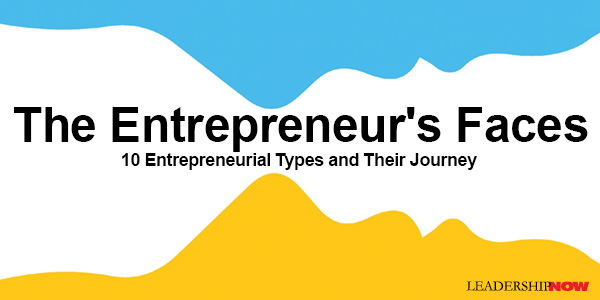
THE leadership we need now can be found in the entrepreneurial mindset—the characteristics found in entrepreneurs. Authors Jonathan Littman and Susanna Camp have categorized the nature of this mindset into ten types or faces in The Entrepreneur’s Faces. More than just static labels, there you’re your pathway into the entrepreneurial mindset and the solutions that can bring. As if the changes in technology haven’t left many wondering what to do next, the reaction to the COVID-19 virus has left many leaders in a kind of limbo. The authors write: We’re adrift – lacking the stabilizing force of the office, the social grounding of a shared workplace, essential interactions with colleagues. For many of us, the pandemic has interrupted our goals and stolen our sense of purpose. We need new ways to lead during the crisis – from how to reshape our careers or work, to how to craft a fresh collaborative model in this instantly all-digital age. They look at these ten different entrepreneurial faces in the framework of the seven stages of the entrepreneurial journey they call The Arc. The Arc illustrates seven stages that all entrepreneurs pass through. In The Entrepreneur’s Faces we get an inside look at ten everyday entrepreneurs as they work through the challenges unique to each stage in the journey.
It is helpful to see how they grow and approach the issues they face from their dominant “face.” Better yet, you can see how they adapted using other faces as needed as they moved through The Arc. Different situations call for different faces. Knowing where you are can help you determine what kind of partners you need to navigate to success.
The Awakening It all begins with the Awakening. It changes how you look at the world and sets you on a path of discovery. The awakening is about something unseen—a surging rush of confidence. You begin to believe you’re capable of more than you’d planned. More than others had expected. You begin to trust that the process is worthwhile and rewarding in an of itself. You become less concerned about what you will discover, and more confident that each day you are growing stronger and more capable, more prepared to capitalizes on whatever is next. As the characters in the book show, your face will shape how you awaken. What follows is an excerpt from the book of the awakening of one entrepreneur, Allan Young. Allan Young, born in San Francisco’s Chinatown, is one of the ten characters in The Entrepreneur’s Faces. Allan embodies the archetype we call the Leader. Intent and action bind at the tightest level in aspiring leaders. Despite humble beginnings, Allan set out on a conscious, focused, and ultimately inspirational journey to become a leader. Allan shed his earlier shortcomings and went on to help lead a wildly successful venture capital fund while still in college and later created Runway, one of San Francisco’s greatest tech accelerators. Allan Young’s Awakening Allan Young’s parents were Chinese immigrants. His mother was a seamstress. His father juggled two jobs, stocking the shelves of a grocery, and working in a hardware store until late. Their work ethic didn’t sink in. Allan was a screw-up. “I wanted to have fun instead of sit in class,” he said. “I’d cut school. Go shoot hoops, or hang out at the Chinatown library.” Yet his fondness for rebellion included a strong streak of intellectual curiosity. In the third grade, he learned to code in BASIC, and loved reading. But computers were for nerds. So he made “a conscious decision to play sports, to be a gangster.” The world needs leaders who are Awakening. Pain often comes before an awakening, but it leads to openness and discovery. A Faces Quiz is available at TheEntrepreneursFaces.com 
Posted by Michael McKinney at 09:41 AM
10.15.20

Leading Thoughts for October 15, 2020
IDEAS shared have the power to expand perspectives, change thinking, and move lives. Here are two ideas for the curious mind to engage with: Fritjof Capra on making change in a living organization: “A machine can be controlled; a living system, according to the systemic understanding of life, can only be disturbed. In other words, organizations cannot be controlled through direct interventions, but they can be influenced by giving impulses rather than instructions. To change the conventional style of management requires a shift of perception that is anything but easy, but it also brings great rewards. Working with the processes inherent in living systems means that we do not need to spend a lot of energy to move an organization. There is no need to push, pull, or bully it to make it change. Force or energy are not the issue; the issue is meaning. Meaningful disturbances will get the organization’s attention and will trigger structural changes.” Source: The Hidden Connections: A Science for Sustainable Living Christina Sommers and Sally Satel on the perils of overthinking: “[There is] the common assumption that intense reflection on troubling thoughts and emotions is rewarded by a clearer vision. What [Stanford University psychologist, Susan] Nolen-Hoeksmea and others have repeatedly shown, however, is that overthinking tends to “impose a lens that shows a distorted, narrow view of the world.” Things that are wrong, not the solutions, are what come most sharply into view. “When you are sad,” Nolen-Hoeksmea explains, “your brain has greater access to sad thoughts and memories, and you are more likely to interpret events in a sad way.” Neural connections between memories with similar emotional color are activated even when we think about depressing incidents that have no apparent relationship to those memories. Source: One Nation Under Therapy: How the Helping Culture Is Eroding Self-Reliance Look for these ideas every Thursday on the Leading Blog. Find more ideas on the LeadingThoughts index.
Posted by Michael McKinney at 05:00 PM
10.12.20

Stay Indispensable by Cultivating These Key Ingredients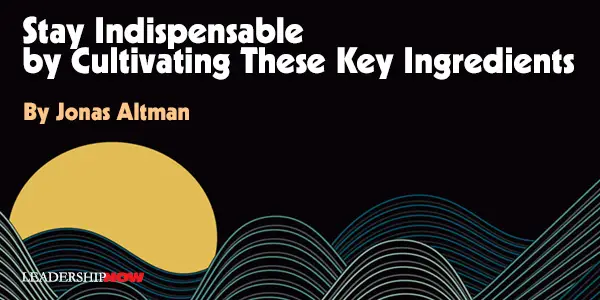
IN 1984 a typical business competency would last 30 years. Today, it’s more akin to five. We’re changing jobs more than ever and pursuing multiple careers and projects simultaneously. Take a moment to consider how many jobs you’ve had and how many careers you’re yet to embark upon? The ability to adapt and thrive at work, also known as your adaptability quotient, demands continuous learning and cultivation. The paradigm shift in work is, first and foremost, a mental one. As humans, what we crave are open, fluid, and personalized systems. And the world of work is gradually opening to provide just that. Enter the shaper. A shaper is someone who gets energized by work. How they work provides for the highest creative expression of self. What shapers do every day serve themselves and the greater good. They are on a path that embraces their uniqueness so as to lead deep and fulfilling lives. Taking a Cue from a Comedian “No one is any one thing,” sums up Martin Short’s outlook on life. He’s one of the few people in comedy who’s capable of laughing on both the outside and the inside. The youngest of five children, when he was 12 years old, his eldest brother died in a car accident. Six years later, his mother died of cancer, and two years after that his father passed away from a stroke. His wife of 30 years died of cancer at age 58. Despite all this, Short still demonstrates an unparalleled joie de vivre—he just keeps moving forward. Whether performing a duet with Steve Martin, embarrassing Drake, or playing a host of oddball characters, he’s always experimenting and learning. He welcomes change and regularly takes risks. The comedic chameleon may well be the funniest man alive. It’s this same strain of continuous reinvention that helps the shaper thrive. Stoicism and Modern Modalities Work is now a process and practice to improve. We must demonstrate the fortitude that comes with owning a growth mindset. We need to play, invent, and create—because in order to build more resiliency. A marked departure from the rigid ways of the past, the new mode of work is much more fluid. It begs us to deal with more ambiguity and complexity. Modern ways of working require us to consistently tap into our cognitive powers, creative energy, and collective genius. The hallmark modality of the new world of work it this fluidity—the ability to move quickly and with dexterity amid constant change. A learned practice that ebbs and flows being fluid is a sign of strength in times of uncertainty. Those that shine in the workplace move with a similar ease to water—flowing in harmony with everything they encounter. Cultivating this practice means seeking change, always improving, and expertly navigating towards a future that’s only coming at us faster. Vital Ingredients Many workers now function like Apps on a smartphone, sitting pretty on top of a company’s operating system (OS). They are selected, downloaded, updated, shared, and deleted on demand. The robustness of this OS and the fluidity of the Apps have become an intricate dance to crack. The onus falls on us to safeguard our positioning. We want to ensure we’re featured on the homescreen, all the while protecting our freedoms. While companies continue to shimmy and shuffle to attract talent, we continue to search for meaning and challenge. These are the vital ingredients to help insulate against existential dread and stay featured on the home screen:
These qualities are embodied by shapers and are always in flux, regularly being flexed, and always improved upon. The intention is to become unflappable and adapt to change with grace. Like Martin Short, taking a diverse and nimble approach to work is one way to deal with volatility. And while having a solid skill set is a great start, it’s really the ability to move fluidly between different disciplines while learning new skills on the go that differentiate shapers from the crowd.  
Posted by Michael McKinney at 08:15 AM
10.08.20

Leading Thoughts for October 8, 2020
IDEAS shared have the power to expand perspectives, change thinking, and move lives. Here are two ideas for the curious mind to engage with: Hierarchies are not the problem, says Morris Shechtman: “The criticism often leveled at hierarchies has nothing to do with the essential structure and function of the pyramidal model. These problems all come from one source, conflict avoidance. Hierarchies become dysfunctional when decision-makers don’t want to confront redundancy and incompetence and instead bury the problems in another organizational layer. Or they find it too painful to confront difficult but key people who use legitimate roles and functions in illegitimate, destructive ways. Hierarchies don’t do damage to businesses any more than alcohol creates problem drinking. Structures don’t create problems; people do.” Source: Working Without a Net: How to Survive and Thrive in Today's High Risk Business World Robert Pirsig on dynamic learning or being at one with the process: “Sometime look at a novice workman or a bad workman and compare his expression with that of a craftsman whose work you know is excellent and you’ll see the difference. The craftsman isn’t ever following a single line of instruction. He’s making decisions as he goes along. For that reason he’ll be absorbed and attentive to what he’s doing even though he doesn’t deliberately contrive this. His motions and the machine are in a kind of harmony. He isn’t following any set of written instructions because the nature of the material at hand determines his thoughts and motions, which simultaneously change the nature of the material at hand. The material and his thoughts are changing together in a progression of changes until his mind’s at rest at the same time the material’s right.” Source: Zen and the Art of Motorcycle Maintenance: An Inquiry Into Values Look for these ideas every Thursday on the Leading Blog. Find more ideas on the LeadingThoughts index.
Posted by Michael McKinney at 07:07 AM
10.07.20

Five Qualities Genuine Leaders Have in Common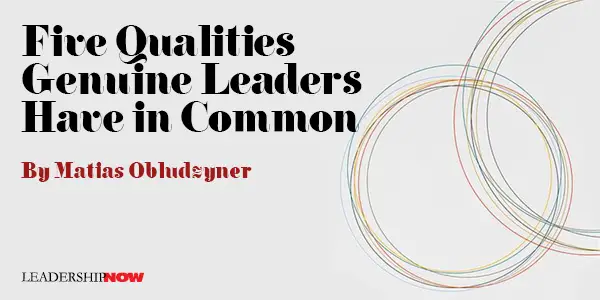
COVID-19 reminds us that we live in a world full of uncertainty—and this will continue well beyond the pandemic. But it only intensifies something we were already seeing in the world of work: organizations need to adapt constantly to keep up with market dynamics. Unfortunately, this can take a toll on employees if businesses focus on efficiency but don’t create an environment where people feel they belong. And with today’s digital economy and globalized markets making organizations more and more decentralized, it’s getting harder than ever for workers to create meaningful relationships with others. A recent MIT study underscores this. It surveyed top professionals from more than 120 countries about the skills needed for effective leadership in the decade ahead. It found that even more than in the past, leaders need to articulate a clear vision and strategy and provide a sense of shared purpose. Employees are expressing this, too. Millennials and Generation Z crave purpose as well as ethical behaviors from their bosses. We saw that when more than 32,000 students in France signed a pledge to work for environmentally conscious companies, or when thousands of Google employees signed a letter protesting the company’s involvement in a government program that uses artificial intelligence to enhance military tactics. Today’s workers also want autonomy and empowerment. They look for a work environment where they can decide how the job gets done. A Gallup study of the American workforce found that 42 percent of Millennials would switch to a job that allows them to work independently on a project of their choosing, and 63 percent to a job that allows them flexible hours. This kind of workplace demands a different kind of leader: people who follow their inner convictions and passions, and who engage with others in an authentic and open way. Leaders who behave like this are especially well-positioned to make a difference—let’s call them genuine leaders. They have a deep understanding of themselves, including their values, ambitions, and goals. They also lead with generosity: they care about others and empower their teams to fulfill their own ambitions. These leaders show you who they are as human beings, rather than hiding behind a mantle of power. They are not afraid to share their personal stories in a way that resonates with others and are able to shape a collective narrative that fosters trust and a common purpose—enabling others to find meaning in their own work. When people work alongside genuine leaders, they become more willing to give their whole hearts and minds to the mission. They feel motivated to work with others, to innovate, and to strive for extraordinary results. For my new book, The Expanding Circle, I interviewed three dozen genuine leaders across industries. While each of them has their own unique style for getting the job done, we can distill five common themes: 1. Achieving clarity of purpose. Genuine leaders have a deep understanding of their values, ambitions, and goals, and project their true selves for all to see. This self-awareness helps them lead with confidence and share their true passion and commitment. This authenticity helps create trust with others. It’s also critical to ensuring collaboration. 2. Crafting a genuine personal story. Humans are hardwired to learn through storytelling. By sharing a personal story that reflects their values and convictions, these leaders help others understand who they are and what they stand for. A story that resonates with others helps build trust and establishes a common ground for working together. 3. Seeking to understand others. Many people rely on their past experiences or even “intuition” to guess what others want. But intuition is a shortcut—and not a particularly good one. Genuine leaders spend time listening to others, asking questions, and exchanging ideas. They avoid prejudging others, which allows them to really see the people they are trying to reach—who they are and what they care about. 4. Shaping a shared narrative. Based on this deep understanding of others, these leaders develop a shared narrative, providing a common purpose and strategic direction: where we need to go, why it matters, and how we’re going to get there. This kind of narrative establishes a framework for teams to work together. 5. Empowering others. Fundamentally, these leaders see their role as creating the right conditions for all team members to take the initiative and contribute their best. They don’t try to micromanage or impose their own working style. They set the strategic direction and trust their team to get things done. And they create space for others to find purpose for themselves and develop their full potential. As we move into this new decade, we need leaders who can tune in fully: to themselves, to others, and to the world around them.  
Posted by Michael McKinney at 08:56 AM
10.05.20

Leading an Emotionally Traumatized Workforce in the Midst of a Pandemic
YOUR COMPANY has begun its phased reopening. You are excited to be back in the office and a more normal routine. However, things are not as normal as you thought they would be. Not everyone shares in your enthusiasm, and the culture of your team seems to have changed. Your team is easily distracted and anxious. Even your top performers are not themselves. You are struggling to understand what the issues are and how to address them. Should you allow performance to seek its own level? Should you remind everyone of the previous performance standards and enforce them rigidly? How long do you let the faltering performance continue? The issue you, as the leader, are experiencing is the complexity of grief caused by a global pandemic. Grief is triggered any time a person faces the loss of what they considered to be their normal reality. The pandemic has caused many realities to shift. Some genuine, and some perceived. Many of these changes are losses. Here are some your people may be experiencing:
Grief takes on many shapes and forms. When the global pandemic struck the United States, it was sudden and unnatural. This generation has never experienced anything like this in our lifetime. When losses of loved ones, employment, a home, or anything people have a deep relationship with are sudden and unnatural, the grief experienced is more profound, more prolonged, and more complex. Our psyche does not know how to process these types of losses. All of the instances cited above are the result of the sudden shift in people’s reality. This scenario is playing out in every business and at every level across the country. The result: people are in denial, people are angry, people are bargaining, and people are depressed—all stages of the grief cycle. Professional sports are not even immune to this as players are electing to sit out the abbreviated seasons as a result of the fear that their team will not be able to keep them safe. So how should a leader deal with this situation? As a leader, it is up to you to adapt your leadership style to help guide employees through their new life and work reality. Adaptive leaders are versatile and adept at balancing the five evaluation attributes of their people: stewardship, trust, empowerment, collaboration, and communication frequency. By adjusting your leadership style across these five elements, the adaptive leader helps grieving or emotionally traumatized employees excel at work through times such as these. Adaptive leaders understand that employees who experience an emotionally traumatic event are not the same people when they return to work as they were before the event. Emotionally traumatic events impact both the person's ability to perform and their potential while they work through the event and the subsequent grief emotions. Here are four tips for leading through these times:
We are not suggesting leaders relax performance standards or take a soft approach to leading—quite to the contrary. What we are recommending is the most challenging form of leadership. We are suggesting the leader should confront the issues head-on, but only after genuinely seeking to understand what the issues are from the employee’s point of view. It takes a strong and confident leader to engage people on a personal and emotional level. If you implement these four tips, your team will see you as a compassionate leader who is willing to adapt your style to meet them where they are as they navigate their new realities. Now more than ever, people are looking to their employer to demonstrate that they care about them. How a leader deals with these difficult situations sends a highly visible message. The result will be higher levels of trust in you and the organization, higher morale, higher productivity, and higher levels of loyalty and engagement. We would enjoy hearing about your leadership experiences as they relate to this topic. Visit our website, www.griefleaders.com, and share your story on our contact page.  
Posted by Michael McKinney at 07:02 AM
10.01.20

First Look: Leadership Books for October 2020Here's a look at some of the best leadership books to be released in October 2020. Don't miss out on other great new and future releases not listed here.
In the modern workplace, employees collaborate. Managers are expected to be effective team leaders and employees are expected to be valued teammates. But many teams struggle. Being part of a struggling team can be unpleasant, but it can also hurt your career and waste company resources. In Teams That Work, Tannenbaum and Salas present the seven drivers of team effectiveness and the clearest recommendations on what really makes teams great. Applying the lessons they've learned from working with high-stakes, high-risk team situations to any kind of organization, they will dispel some of the most enduring myths (e.g., can you be both a star and a great team player?), feature the most useful psychological research, and share real-world illustrations of effective teams in action. Readers will find actionable, evidence-based tips for being an effective team leader, a great team member, a supportive senior leader, or an impactful consultant.
There's an 80 percent chance you're poor. Time poor, that is. Four out of five adults report feeling that they have too much to do and not enough time to do it. These time-poor people experience less joy each day. They laugh less. They are less healthy, less productive, and more likely to divorce. In one study, time stress produced a stronger negative effect on happiness than unemployment. How can we escape the time traps that make us feel this way and keep us from living our best lives? Time Smart is your playbook for taking back the time you lose to mindless tasks and unfulfilling chores. Author and Harvard Business School professor Ashley Whillans will give you proven strategies for improving your "time affluence."
What drives us to unleash our best work? And how do we tap into that drive to get superior results with our managers, coworkers, and direct reports? As Todd Henry reveals in this book, drawing on decades of research and interviews with over 100,000 people, the answer is not one size fits all: some people are energized by a race against the clock, while others put in extra effort only when they feel part of a team. For still others, nothing is as motivating as the possibility of public recognition. Henry shows, in fact, that there are twenty-seven "motivational themes”, each with its own unique DNA. The Motivation Code teaches us to decode our Core Motivation so that we can have conversations, make decisions, and even choose career paths that lead us to experience engagement and fulfillment.
Among the most successful leaders throughout history―from Abe Lincoln to Rosa Parks, Mahatma Gandhi to Susan B. Anthony, Martin Luther King, Jr. to Nelson Mandela―some were brilliant mathematicians and economists, others were creative visionaries, still others were masterful at strategic planning. Their mastery of their field wasn’t the secret to their highly effective leadership. All of their skill, grit, resilience, charisma, and courage emanated from one thing: their strength of character. In The Character Edge the authors leverage their perspectives to offer an empowering, story-driven argument―backed by the latest scientific research―that character is vital to success.
Leaders have experimented with open innovation programs, corporate accelerators, venture capital arms, skunkworks, and innovation contests. They've trekked to Silicon Valley, Shenzhen, and Tel Aviv to learn from today's hottest, most successful tech companies. Yet most would admit they've failed to create truly innovative cultures. There's a better way. And it all starts with the power of habit. In Eat, Sleep, Innovate, uses groundbreaking research in behavioral science to provide a first-of-its-kind playbook for empowering individuals and teams to be their most curious and creative—every single day. Throughout the book, the authors reveal a collection of BEANs—behavior enablers, artifacts, and nudges—they've collected from workplaces across the globe that will unleash the natural innovator inside everyone.
Among our greatest leaders are those driven by impulses they cannot completely control - by lust. Lust is not, however, an abstraction, it has definition. Definition that, given the impact of leaders who lust, is essential to extract. This book identifies six types of lust with which leaders are linked: 1. Power: the ceaseless craving to control. 2. Money: the limitless desire to accrue great wealth. 3. Sex: the constant hunt for sexual gratification. 4. Success: the unstoppable need to achieve. 5. Legitimacy: the tireless claim to identity and equity. 6. Legacy: the endless quest to leave a permanent imprint. Each of the core chapters focuses on different lusts and features a cast of characters who bring lust to life.
 Build your leadership library with these specials on over 32 titles. All titles are at least 40% off the list price and are available only in limited quantities. “Reading is the nourishment that lets you do interesting work.” — Jennifer Egan
Posted by Michael McKinney at 07:41 AM

Leading Thoughts for October 1, 2020
IDEAS shared have the power to expand perspectives, change thinking, and move lives. Here are two ideas for the curious mind to engage with: Tasha Eurich on the two aspects of self-awarenesss: “Put simply, self-awareness is not one truth. It’s a complex interweaving of our views and others’ views of us. Indeed, according to studies on this topic, these two different perspectives, rather than capturing redundant information, may simply capture different aspects of who we are. If we have only internal or only external self-awareness, we’re missing a huge piece of the puzzle.” Robert Quinn on real leadership: “Leadership is not about results. It is about commitment. The entire management literature fails to understand this. Leadership authors do not understand that leadership means “Go forth and die.” If hey did understand it, they would not be enticed to write about it—because people do not want to hear this message. Most people want to be told how to get extraordinary results with minimum risk.” Source: Change the World: How Ordinary People Can Achieve Extraordinary Results Look for these ideas every Thursday on the Leading Blog. Find more ideas on the LeadingThoughts index.
Posted by Michael McKinney at 12:10 AM
|
BUILD YOUR KNOWLEDGE


How to Do Your Start-Up Right STRAIGHT TALK FOR START-UPS 
Grow Your Leadership Skills NEW AND UPCOMING LEADERSHIP BOOKS 
Leadership Minute BITE-SIZE CONCEPTS YOU CAN CHEW ON 
Classic Leadership Books BOOKS TO READ BEFORE YOU LEAD |
|